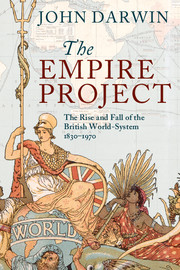Book contents
- Frontmatter
- Contents
- List of maps
- Preface and acknowledgments
- Introduction: the project of an Empire
- Part I Towards ‘The Sceptre of the World’: the elements of Empire in the long nineteenth century
- Part II ‘The great liner is sinking’: the British world-system in the age of war
- Conclusion
- Notes
- Select bibliography
- Index
Introduction: the project of an Empire
Published online by Cambridge University Press: 11 December 2009
- Frontmatter
- Contents
- List of maps
- Preface and acknowledgments
- Introduction: the project of an Empire
- Part I Towards ‘The Sceptre of the World’: the elements of Empire in the long nineteenth century
- Part II ‘The great liner is sinking’: the British world-system in the age of war
- Conclusion
- Notes
- Select bibliography
- Index
Summary
For more than a century after c.1840, the British Empire formed the core of a larger British ‘world-system’ managed from London. This book is a study of the rise, fortunes and fall of that system.
The British world-system was not a structure of global hegemony, holding in thrall the non-Western world. Except in particular places and at particular times, such hegemonic authority eluded all British leaders from Lord Palmerston to Churchill. But the British ‘system’ (a term that contemporaries sometimes made use of) was much more than a ‘formal’ territorial empire, and certainly global in span. It embraced an extraordinary range of constitutional, diplomatic, political, commercial and cultural relationships. It contained colonies of rule (including the huge ‘sub-empire’ of India), settlement colonies (mostly self-governing by the late nineteenth century), protectorates, condominia (like the Sudan), mandates (after 1920), naval and military fortresses (like Gibraltar and Malta), ‘occupations’ (like Egypt and Cyprus), treaty-ports and ‘concessions’ (Shanghai was the most famous), ‘informal’ colonies of commercial pre-eminence (like Argentina), ‘spheres of interference’ (a useful term coined by Sellars and Yeatman) like Iran, Afghanistan and the Persian Gulf, and (not least) a rebellious province at home. There was no agreed term for this far-flung conglomerate. This may have been why contemporaries sometimes found it convenient to fall back on that protean phrase ‘the Pax Britannica’ once it came into use after 1880, as if the ‘British Peace’ formed a geographical zone.
Information
- Type
- Chapter
- Information
- The Empire ProjectThe Rise and Fall of the British World-System, 1830–1970, pp. 1 - 20Publisher: Cambridge University PressPrint publication year: 2009
Accessibility standard: Unknown
Why this information is here
This section outlines the accessibility features of this content - including support for screen readers, full keyboard navigation and high-contrast display options. This may not be relevant for you.Accessibility Information
- 1
- Cited by
